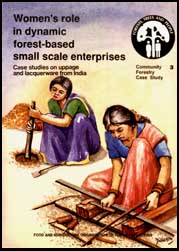
COMMUNITY FORESTRY NOTE 4
FORESTS, TREES AND PEOPLE
Edited with an Introduction and Conclusion by:
Jeffrey y Campbell
FOOD AND AGRICULTURE ORGANIZATION OF THE UNITED
NATIONS
Rome, 1991
|
The designations employed and the presentation of material in
this publication do not imply the expression of any opinion whatsoever on the
part of the Food and Agriculture Organization of the United Nations concerning
the legal status of any country, territory, city or area or of its authorities,
or concerning the delimitation of its frontiers or boundaries. |
All rights reserved. No part of this publication may be reproduced, stored in a retrieval system, or transmitted in any form or by any means, electronic, mechanical, photocopying or otherwise, without the prior permission of the copyright owner. Applications for such permission, with a statement of the purpose and extent of the reproduction, should be addressed to the Director, Publications Division, Food and Agriculture Organization of the United Nations, Via delle Terme di Caracalla, 00100 Rome, Italy.
This electronic document has been scanned using optical character recognition (OCR) software and careful manual recorrection. Even if the quality of digitalisation is high, the FAO declines all responsibility for any discrepancies that may exist between the present document and its original printed version.
1.1: General background
1.2: Characteristics of FBSSEs
1.3: Issues and constraints for FBSSEs in generalDiminishing availability of raw materials
Insecure markets/fluctuating commercial value
Introduction of new technology
Access to alternate sources of income
Lack of entrepreneurial/managerial skills
Degree of institutional support1.4: Women's involvement in FBSSEs
The situation in Karnataka
Characteristics of FBSSEs in which women's participation is most common
CHAPTER 2: CASE STUDY 1 - UPPAGE COLLECTION
2.1: Introduction
2.2: The study site
2.3: Description and uses of uppage
2.4: Women's role in traditional uppage collection
2.5: New markets
2.6: Uppage collection2.8: Three collectors' case histories
2.9: Contractors, collection agents and the marketing chainContractors
Collection agents
Wholesale and retail marketing2.10: Institutional issues and involvement
The role of government agencies
Cooperative collection of uppage2.11: Sustaining the resource base, implications for management
2.12: Implications for women
CHAPTER 3: CASE STUDY 2 - LAC-TURNERY AND THE LACQUERWARE INDUSTRY
3.1: Introduction
3.2: The study site
3.3: Lacquerware and lac-turnery defined
3.4: Lac-turnery, the materials and the process3.5: Historical development of the industry
3.6: The lacquerware industry todayChanging markets and changing products
Classifications within the industry3.7: Institutional involvement in production
Training centres
Production and marketing centres
Other institutions involved in lacquerware3.8: Women's participation in lac-turnery
The nature of women's participation
Composition of the sample sites
Women's participation rates
Product and market differentiation
Employment and income patterns
Experience levels and case histories3.9: Constraints and issues for women in lac-turnery today
Raw material supply
Exploitation by traders/static prices
Problems with institutional training
4.1: Brief summary
4.2: Major issues and constraintsThe importance of household socio-economic factors
Commercialization stimulates competition/attracts men
Increasingly organized collection restricts access
Access to technology is often unequal
Changes in technology may displace women
Institutional support and training frequently favour men
Increasing impact on the natural resource base